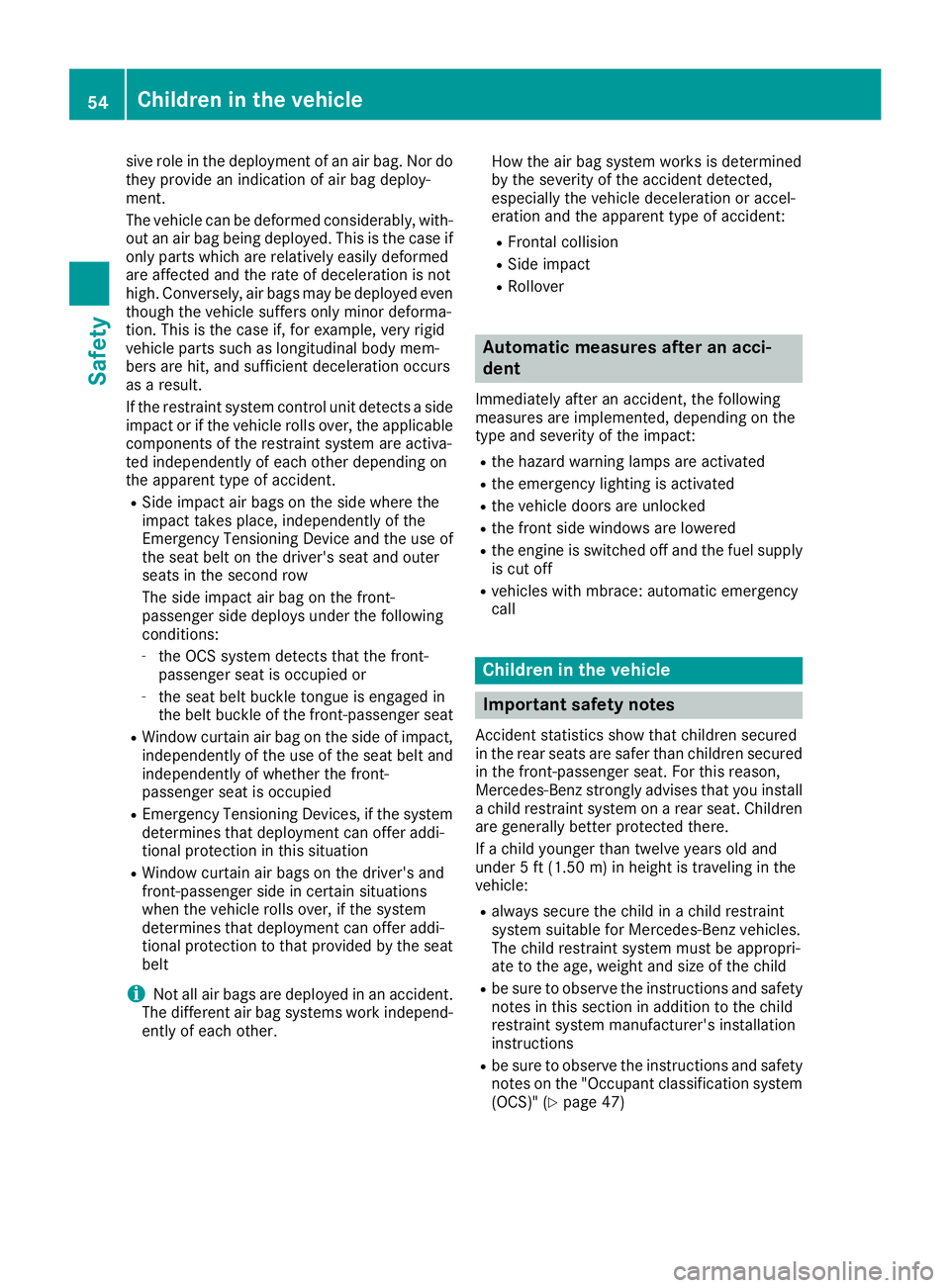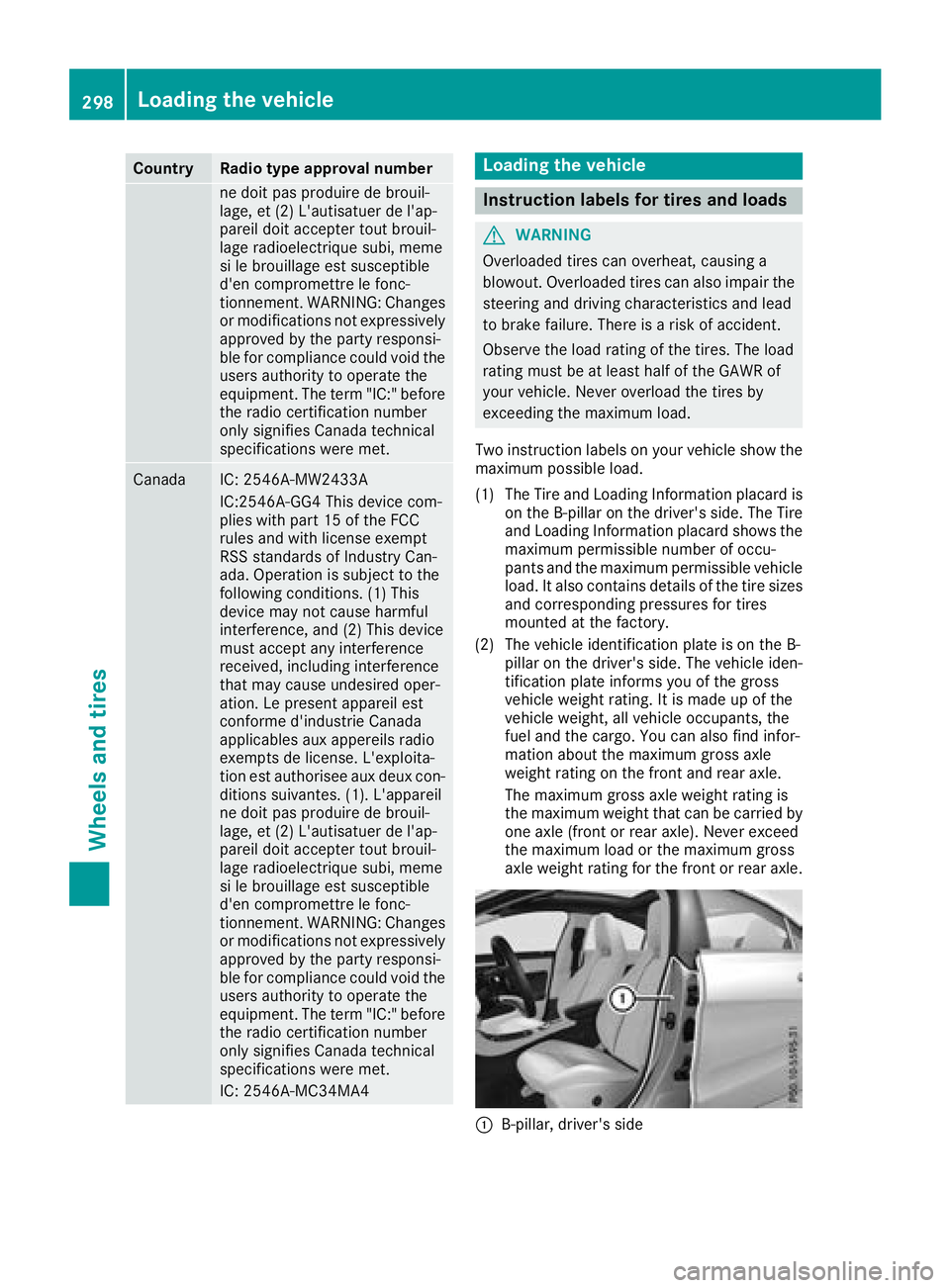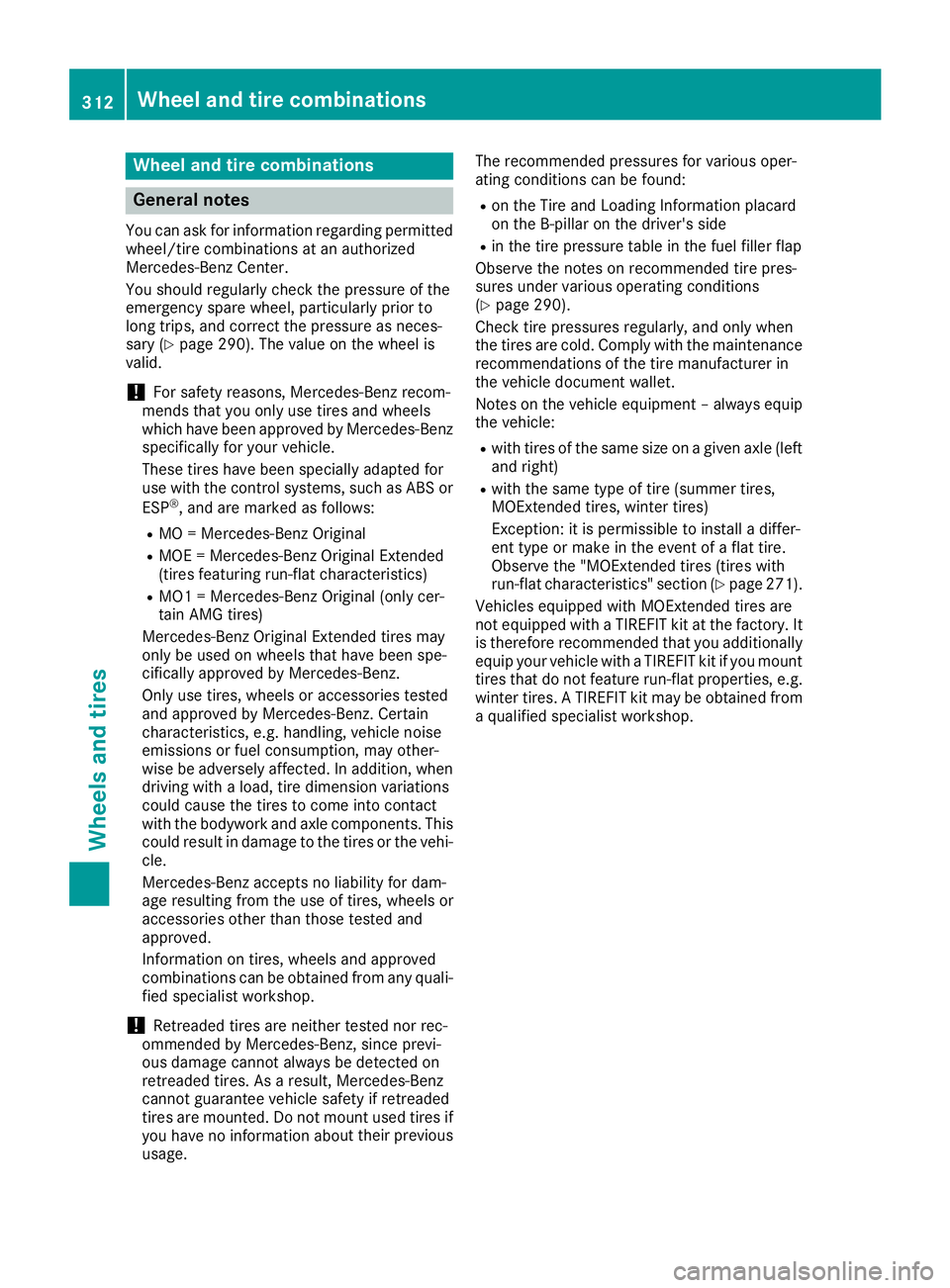2018 MERCEDES-BENZ CLA fuel type
[x] Cancel search: fuel typePage 18 of 326

Remote control
Garag ed oo ro pener ....................... 252
Programming (garag ed oor
opener) .......................................... 252
Replacing bulbs
Brake lamp .................................... 106
High-beam headlamp s. .................. 106
Important safety notes .................. 104
Installing/removing the cover
(front whee la rch ). ......................... 105
Low-bea mh eadlamp s. ................... 105
Overview of bulb types .................. 104
Rear fog lamp ................................ 106
Turn signal s( front) ......................... 106
Turn signal s( rear) .......................... 106
Reporting safety defects .................... 28
Rescue card ......................................... 29
Reserve (fuel tank)
see Fuel
Reserve fuel
Displa ym essage ............................ 206
Warning lamp ................................. 224
see Fuel
Residual hea t( clim ate control) ........ 119
Restrain ts ystem
Displa ym essage ............................ 198
Introduction ..................................... 40
Warning lamp ................................. 224
Warning lamp (function) ................... 41
Revers eg ea r( selecto rl ever ) ........... 132
Reversin gf eature
Roller sunblind ................................. 87
Sid ew in dow s. .................................. 82
Roadside Assistance (breakdown) .... 26
Rolle rs unblind
Panorama roo fw it hp ower tilt/
sliding panel ..................................... 87
Roo fc arrier ........................................ 241
Roo fl inin ga nd carpets (cleaning
guidelines) ......................................... 268
Roo fl oa d( maximum) ........................ 320
Route guidance
see also Digital Operator's Man-
ua l. ................................................. 229 S Safety
Childre nint he vehicl e. .................... 54
see Occupant safety
Safety system
see Driving safety systems
SD card
Inserting ........................................ 235
Inserting/removing ........................ 235
Removing ....................................... 235
SD memory card
see also Digital Operator's Man-
ua l. ................................................. 229
Search &S en d
see also Digital Operator's Man-
ua l. ................................................. 229
Seat
Correct driver' ss ea tp osition ........... 90
Seat belts
Adjusting the height ......................... 44
Cleaning ......................................... 267
Correct usag e. ................................. 43
Fastening ......................................... 44
Important safety guideline s. ............ 42
Introduction ..................................... 41
Releasing ......................................... 44
Warning lamp ................................. 218
Warning lamp (function) ................... 44
Seats
Adjusting (electrically) ..................... 92
Adjusting (manually) ........................ 91
Adjusting (Performance Seat) .......... 94
Adjusting the 4-wa yl um ba rs up -
por t. ................................................. 93
Adjusting the hea dr estraint ............ 92
Cleaning the cove r. ........................ 267
Folding the backres t( rear com-
partment) forwards/back .............. 240
Important safety notes .................... 90
Sea th eating problem ...................... 95
Storing settings (memory func-
tion) ................................................. 99
Switching sea th eating on/of f. ........ 94
Securing cargo .................................. 241
Selecto rl ever
Cleaning ......................................... 267
Sensors (cleaning instructions) ....... 26516
Index
Page 56 of 326

sive role in the deployment of an air bag. Nor do
they provide an indication of air bag deploy-
ment.
The vehicle can be deformed considerably, with-
out an air bag being deployed. This is the case if
only parts which are relatively easil yd eformed
are affected and the rate of deceleration is not
high. Conversely, air bags may be deployed even
though the vehicle suffers only minor deforma-
tion. This is the case if, for example, very rigid
vehicle parts such as longitudinal body mem-
bers are hit, and sufficient deceleration occurs
as ar esult.
If the restraint system control unit detects as ide
impact or if the vehicle rolls over, the applicable
component soft he restraint system are activa-
ted independently of each other depending on
the apparent type of accident. R
Side impact air bags on the side where the
impact takes place, independently of the
Emergenc yT ensioning Device and the use of
the seat belt on the driver's seat and outer
seats in the second row
The side impact air bag on the front-
passenger side deploy su nder the following
conditions: -
the OCS system detects that the front-
passenger seat is occupied or -
the seat belt buckle tongue is engaged in
the belt buckle of the front-passenger seat R
Window curtain air bag on the side of impact,
independently of the use of the seat belt and
independently of whether the front-
passenger seat is occupied R
Emergenc yT ensioning Devices, if the system
determines that deployment can offer addi-
tional protection in this situation R
Window curtain air bags on the driver's and
front-passenger side in certain situations
when the vehicle rolls over, if the system
determines that deployment can offer addi-
tional protection to that provided by the seat
belt
i Not all air bags are deployed in an accident.
The different air bag systems work independ-
ently of each other. How the air bag system works is determined
by the severity of the accident detected,
especially the vehicle deceleration or accel-
eration and the apparent type of accident: R
Frontal collision R
Side impact R
Rollover
Automatic measures after an acci-
dent Immediately after an accident, the following
measures are implemented, depending on the
type and severity of the impact: R
the hazard warning lamps are activated R
the emergency lighting is activated R
the vehicle doors are unlocked R
the front side windows are lowered R
the engine is switched off and the fuel supply
is cut off R
vehicles with mbrace: automatic emergency
call
Children in the vehicle
Important safety notes Accident statistics show that children secured
in the rear seats are safer than children secured
in the front-passenger seat. For this reason,
Mercedes-Benz strongly advises that you install
ac hild restraint system on ar ear seat. Children
are generally better protected there.
If ac hild younger than twelve years old and
under 5ft( 1.50 m) in height is traveling in the
vehicle: R
always secure the child in ac hild restraint
system suitable for Mercedes-Benz vehicles.
The child restraint system must be appropri-
ate to the age, weight and size of the child R
be sure to observe the instructions and safety
notes in this section in addition to the child
restraint system manufacturer's installation
instructions R
be sure to observe the instructions and safety
notes on the "Occupant classification system
(OCS)" ( Y
page 47)54
Children in the vehicle
Safety
Page 300 of 326

Country Radio type approval number
ne doit pas produire de brouil-
lage, et (2) L'autisatuer de l'ap-
pareil doit accepter tout brouil-
lage radioelectrique subi, meme
si le brouillage est susceptible
d'en compromettre le fonc-
tionnement. WARNING: Changes
or modifications not expressively
approved by th ep art yr esponsi-
ble for compliance could void the
users authorit yt oo perate the
equipment .T he ter m" IC: "b efore
th er adio certification number
onl ys ignifies Canada technical
specifications were met.
Canada IC: 2546A-MW2433A
IC:2546A-GG4 This devic ec om-
plies with part 15 of th eF CC
rules and with licens ee xempt
RSS standards of Industry Can-
ada. Operatio niss ubject to the
following conditions. (1) This
devic em ay not cause harmful
interference, and (2) This device
must accept any interference
received ,i ncludin gi nterference
that may cause undesire do per-
ation. Le present appareil est
conforme d'industrie Canada
applicables aux appereils radio
exempt sdel icense. L'exploita-
tio ne st authorisee aux deux con-
dition ss uivantes .( 1). L'appareil
ne doit pas produire de brouil-
lage, et (2) L'autisatuer de l'ap-
pareil doit accepter tout brouil-
lage radioelectrique subi, meme
si le brouillage est susceptible
d'en compromettre le fonc-
tionnement. WARNING: Changes
or modifications not expressively
approved by th ep art yr esponsi-
ble for compliance could void the
users authorit yt oo perate the
equipment .T he ter m" IC: "b efore
th er adio certification number
onl ys ignifies Canada technical
specifications were met.
IC: 2546A-MC34MA4 Loading th ev ehicle
Instruction labels for tires and loads
G WARNING
Overloade dt ires can overheat ,c ausing a
blowout .O verloade dt ires can also impair the
steerin ga nd driving characteristic sa nd lead
to brak ef ailure. Ther eisar isk of accident.
Observe th el oad rating of th et ires. The load
rating must be at least half of th eG AWR of
your vehicle .N ever overload th et ires by
exceedin gt he maximum load.
Two instruction labels on your vehicle show the
maximum possible load.
(1) The Tire and Loadin gI nf ormation placar di s
on th eB -p illar on th ed river' ss ide. The Tire
and Loadin gI nf ormation placar ds hows the
maximum permissible number of occu-
pant sa nd th em aximum permissible vehicle
load. It also contain sd etails of th et ir es izes
and corresponding pressures for tires
mounted at th ef actory.
(2) The vehicle identification plat eisont he B-
pillar on th ed river' ss ide. The vehicle iden-
tification plat ei nform sy ou of th eg ross
vehicle weight rating .Itism ade up of the
vehicle weight ,a ll vehicle occupants, the
fuel and th ec argo. You can also fin di nfor-
mation about th em aximum gross axle
weight rating on th ef ront and rear axle.
The maximum gross axle weight rating is
th em aximum weight that can be carried by
one axle (front or rear axle) .N ever exceed
th em aximum load or th em aximum gross
axle weight rating for th ef ront or rear axle.
�C
B-pillar ,d river' ss ide298
Loading th ev ehicle
Wheels and tires
Page 314 of 326

Whee la nd tire combinations
General notes You can ask for information regarding permitted
wheel/tire combinations at an authorized
Mercedes-Benz Center.
You should regularl yc heck the pressure of the
emergency spare wheel, particularly prio rt o
long trips, and correct the pressure as neces-
sary ( Y
pag e2 90). The valu eont he wheel is
valid.
! For safety reasons, Mercedes-Benz recom-
mends that you only use tires and wheels
which have been approved by Mercedes-Benz
specifically for you rv ehicle.
These tires have been speciall ya dapted for
use with the control systems, such as ABS or
ESP ®
,a nd are marked as follows:R
MO = M ercedes-Benz OriginalR
MOE = M ercedes-Benz Original Extended
(tires featuring run-fla tc haracteristics)R
MO1 = M ercedes-Benz Original (only cer-
tain AMG tires)
Mercedes-Benz Original Extended tires may
only be use donw heels that have been spe-
cifically approved by Mercedes-Benz.
Only use tires, wheels or accessories tested
and approved by Mercedes-Benz. Certain
characteristics, e.g. handling, vehicl en oise
emissions or fuel consumption, may other-
wis ebea dversely affected .Ina ddition, when
driving with al oad, tire dimension variations
coul dc aus et he tires to come into contact
with the bodywork and axle components. This
coul dr esult in damage to the tires or the vehi-
cle.
Mercedes-Benz accepts no liability for dam-
age resulting from the use of tires, wheels or
accessories other than those tested and
approved.
Informatio nont ires, wheels and approved
combinations can be obtained from any quali-
fied specialist workshop.
! Retreaded tires are neither tested nor rec-
ommende dbyM ercedes-Benz, since previ-
ous damage cannot alway sbed etected on
retreaded tires. As ar esult, Mercedes-Benz
cannot guarantee vehicl es afety if retreaded
tires are mounted .Don ot mount use dt ires if
you have no information abo ut thei r previous
u
sage. The recommende dp ressures for various oper-
ating conditions can be found: R
on the Tire and Loading Informatio np lacard
on the B-pillar on the driver's side R
in the tire pressure tabl eint he fuel filler flap
Observe the notes on recommende dt ire pres-
sure su nder various operating conditions
( Y
pag e2 90).
Check tire pressures regularly ,a nd only when
the tires are cold. Comply with the maintenance
recommendations of the tire manufacturer in
the vehicl ed ocument wallet.
Notes on the vehicl ee quipment –a lway se quip
the vehicle: R
with tires of the same size on ag ive na xle (left
and right) R
with the same type of tire (summer tires,
MOExtended tires, winter tires)
Exception: it is permissible to instal lad iffer-
ent type or make in the event of af lat tire.
Observe the "MOExtended tires (tires with
run-fla tc haracteristics" section ( Y
pag e2 71).
Vehicles equipped with MOExtended tires are
not equipped with aT IREFIT kit at the factory .I t
is therefore recommende dt hat you additionally
equip you rv ehicl ew ith aT IREFIT kit if you mount
tires that do not feature run-fla tp roperties, e.g.
winter tires. AT IREFIT kit may be obtained from
aq ualified specialist workshop.312
Whee la nd tire combinations
Wheels and tires